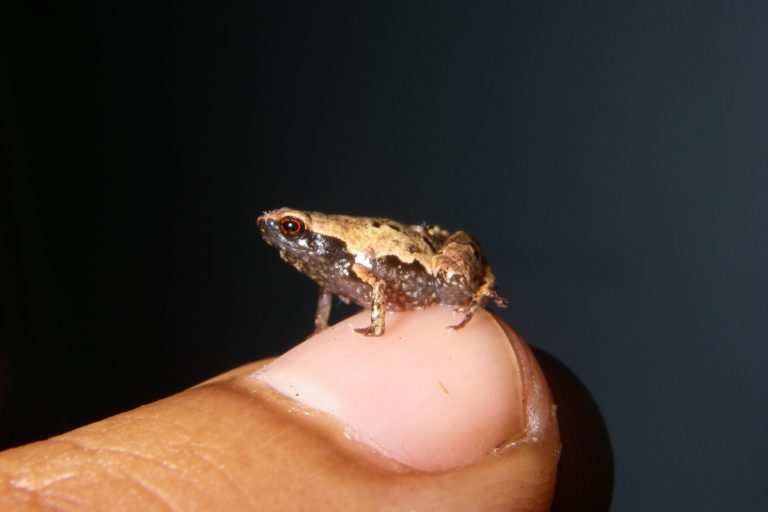From giant to tiny: Meet the new species of the past year
October 14, 2020
The quest for knowledge about our own planet marches steadily onward. In the past year, researchers have described 71 new species, from frogs to sharks to trees with human-sized leaves. Here are five of the most interesting new species from 2019.
1. Madrella amphora, a colorful sea slug

Vibrant colors aren’t the only thing unique about this sea slug- its pattern and texture closely resemble the snail eggs that are often found in and around its habitat. Several sea slug species can replicate the colors and patterns of other species, but they rarely are able to mimic other animals. Madrella amphora is part of the Madrellidae family, a group of marine gastropod mollusks known as nudibranchs that are usually found in shallow, tropical waters. These sea slugs use their antennae-like appendages to search for food as they slide along the ocean floor.
2. Coccoloba gigantifolia and its 8 foot long leaves

Believe it or not, this new species of tree is related to sunflowers, tomatoes, and roses. Found in the Brazilian Amazon, it may be the largest species of dicotyledenous plants, which are plants that have two embryonic leaves. These leaves, also known as cotyledons, are the first leaves to sprout from the seed. Coccoloba gigantifolia’s leaves can be as long as 8 feet, while the total height of the tree is usually somewhere around 49 feet. The tree was first discovered in 1982, but it took until last year for it to be recognized as a species due to difficulties in gathering specimens. The leaves were so big that it was impossible to carry them out of the jungle without damaging them!
3. Mini mum, mini ature, and mini scule

Yes, those are the actual scientific names of these three new frog species. These tiny frogs, found in southeastern Madagascar, belong to the genus ‘mini’ which is also new to science. Mini mum, the smallest of these frogs, is only about 8 to 10 millimeters long, roughly the size of a paper staple. Mini mum also seems to be the rarest of the group and is already considered to be critically endangered. But why are these frogs so little? It is believed that they evolved this way to allow them to hunt small prey like ants and termites.
4. Mico munduruku has a rapidly disappearing habitat

This new species of marmoset is in trouble. Found in the Amazon rainforest, Mico munduruku, along with other types of marmosets and many other animals, is in danger of losing its habitat due to deforestation. It lives in the ‘arc of deforestation’, an area of the Amazon that is quickly being transformed into agricultural land. It is one of the only marmoset species in the Amazon to have a white tail, so researchers were quickly clued in that it could be an entirely new species. Marmosets use their sharp claws to climb trees and are able to tear into tree bark with their incisors and canines to search for a meal.
5. The American pocket shark is a light in the dark

The pocket shark is named not for its small size, but for pocket-like structures found on its body. It has another unique feature- it can secrete a glow-in-the-dark substance that attracts prey. The American pocket shark is only the second species of pocket shark to be described, and its discovery was quite surprising. Researchers were looking into the feeding habits of sperm whales in the Gulf of Mexico when they caught a shark that none of them had ever seen before. Studies on this specimen quickly revealed that it was a different species than the previously described pocket shark.
Works Cited
Dasgupta, Shreya. “Photos: 15 new species of 2019.” Mongabay, 26 Dec. 2019, news.mongabay.com/2019/12/photos-top-15-new-species-of-2019/. Accessed 4 Oct. 2020.
Donahue, Michelle Z. “New staple-size frog is one of the tiniest ever discovered.” National Geographic, 27 Mar. 2019, www.nationalgeographic.com/animals/2019/03/smallest-frog-species-discovered-mini-mum/#:~:text=Mini%20mum%2C%20Mini%20ature%2C%20and,all%2Dnew%20genus%20of%20frog. Accessed 5 Oct. 2020.
Imster, Eleanor. “Researchers describe 71 new species in 2019.” EarthSky, 11 Dec. 2019, earthsky.org/earth/new-species-discovered-in-2019. Accessed 4 Oct. 2020.
Knight, Skylar. “Academy scientists describe 71 species in 2019.” California Academy of Sciences, 5 Dec. 2019, www.calacademy.org/press/releases/academy-scientists-describe-71-species-in-2019. Accessed 4 Oct. 2020.
O’Kane, Caitlin. “New species of glow-in-the-dark shark found in Gulf of Mexico.” CBS News, 22 July 2019, www.cbsnews.com/news/new-species-of-glow-in-the-dark-sharks-found-in-gulf-of-mexico/. Accessed 5 Oct. 2020.
Williams, Nathan. “New monkey species discovered in rapidly-deforested area of Amazon.” BirdLife International, 9 Aug. 2019, www.birdlife.org/worldwide/news/new-monkey-species-discovered-rapidly-deforested-area-amazon. Accessed 5 Oct. 2020.



































